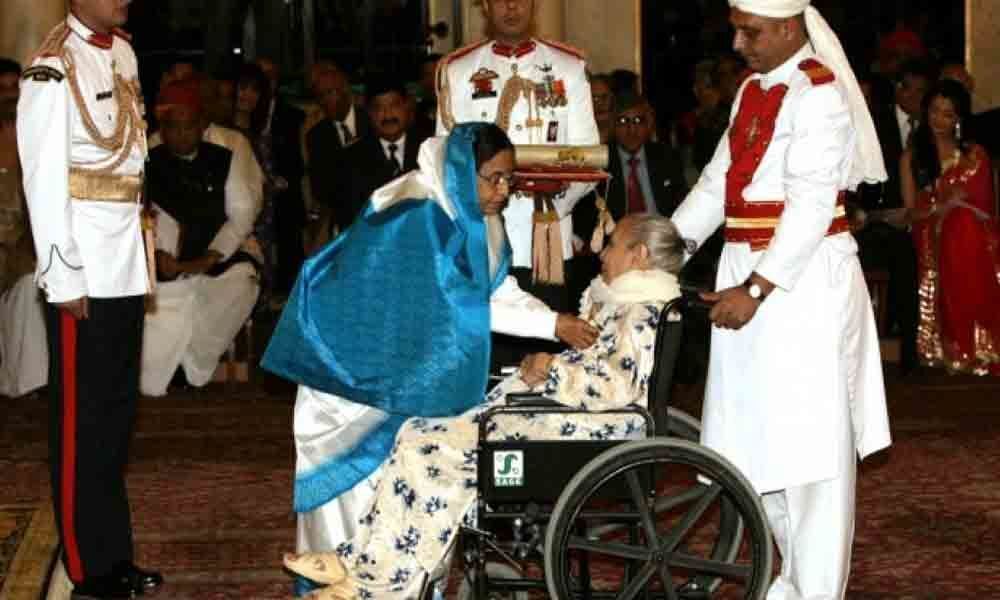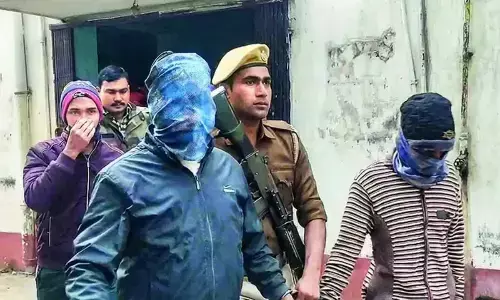India's first queen of playback singing
'Mere Piya Gaye Rangoon', 'Kabhi Aar Kabhi Paar' and 'Kajra Mohabbat Wala', ‘Teri Mehfil Mein Kismat Aazmaakar’...1600 songs for hundreds of films composed by master music directors; Shamshad Begum is one of the first playback singers in the Hindi film industry. April 14, 2019 marks the birth centenary of the legendary singer
Birth centenaries are special occasions. Especially if the person in question had been alive, though not always in public memory, till a few years before. Shamshad Begum (1919-2013), India's most celebrated playback singer in the first half of 20th century and later was one such celebrity. A reclusive figure, who retreated all on her own from the spotlight, which was constantly on her, Begum was an amazing talent, all self-learnt, yet impactful enough to destroy competition effortlessly.
Battling a conservative family environment, marrying outside her religion, combating vehement parental opposition and staying firm in her pursuit of her career, and observing all the diktats imposed on her, Shamshad walked the thin line between patriarchy and passion to excel in an industry, which was awakening to torrential talent inflows from all corners of the subcontinent.
A wealth of data which is available on the Net gives out interesting nuggets about her life and times. As a report in the Millennium Post says: With more than 1,600 songs to her credit, Shamshad Begum created magic from behind the curtains. Even today, she is among the most remembered singers with vast remixes of her golden songs flooding the market.
Love for music
Shamshad Begum was born on April 14, 1919, in Amritsar, Punjab. Her family was least inclined towards music. But there was a gramophone at home, a status symbol in those days. Baby Shamshad would sit in front of the horn of the gramophone, listen to the songs and start crooning. She was also leading the morning prayers in her school.
Incidentally, Master Ghulam Haider was well known to Shamshad's family. Once he heard her and saw huge potential in the talented singer. He was working for Jenaphone Recording Company as its chief composer. He recorded a Punjabi song, 'Haath joda pakhiya da', in Shamshad's voice. The Company liked the song immensely and recorded 200 songs of this legendary singer in a year's time. Shamshad was barely 12 and received a royal sum of Rs 12.50 per song. She was around 12 or 13 during the time. Ghulam Haider helped her fine-tune her vocal skills and referred to her as his 'chaumukhiya', meaning an all-round artist who could sing any song. Very soon, offers were pouring in to sing on All India Radio Lahore and Peshawar. Also known for singing religious compositions, Shamshad recorded a famous 'naat', 'Aaya hai bulawa mujhe darbar-e-nabi se', for All India Radio, Delhi.
Hits after hits
She made her debut on Peshawar Radio in Lahore on December 16, 1947, captivating the hearts of her listeners with her enchanting voice. A prime playback singer of the 1940s, Shamshad Begum was senior to both Noor Jehan and Lata Mangeshkar and got paid one thousand rupees per song, while Lata's fee was in two figures.
Those days Dalsukh M Pancholi was rated among the top producers in Lahore. Having a studio of his own, he had produced films in Punjabi-Hindi and approached Master Haider to compose for these films. Composer Shyam Sunder was assistant to Master Haider and, at his recommendation, Shyam was promoted as the chief composer of Jenaphone. In one of the Punjabi films, Shamshad sang a Master Haider composition, 'Kanka diya faslan pakkiyan', and it took entire Punjab by storm. In 1941, Pancholi announced the film 'Khazanchi' in Hindi, which proved to be the greatest musical hit of its time, as Master Haider made his favourite Shamshad sing all the nine songs, including a duet, 'Sawan ke nazare hain' (picturised on and co-sung by Master Haider). The music of 'Khazanchi' was a trendsetter and Shamshad became a household name with her solo numbers, 'Ek kali nazon ki pali', 'Laut gai papan andheri', 'Diwali phir aa gai sajani' and 'Peene ke din aaye piye jaa'.
Tryst with Bombay
With all the songs becoming chartbusters, 'Khazanchi' was a landmark in Shamshad's career. Another rewarding film for Shamshad was Pancholi's 'Poonji'. The superhits of this film were 'Kya mast hawayein hain' and many others. After the success of Poonji, Shamshad was flooded with offers from Bombay too. When Mehboob Khan made 'Taqdir', starring Motilal and Nargis, he invited Shamshad, at the suggestion of Rafiq Ghaznavi, the music director of the film. Shamshad sang duets with Motilal and Ghaznavi, and 'O jaane wale aaja' became a hit. She came from Lahore, recorded the songs, and went back.
After two years of travelling to and fro, she finally decided to make Bombay her permanent abode. In 1945, Mehboob announced his magnum opus period film, 'Humayun', starring Ashok Kumar-Nargis, and invited Master Haider (who had also moved to Bombay) to score the music. Shamshad sang such musical gems for this film, as once again she was under the baton of her mentor. In 1946, Mehboob directed 'Anmol Ghadi' with a star cast of Surendra, Noor Jahan and Suraiya. All of them sang memorable hit numbers, but the duet of Shamshad and Zohrabai Ambalewali, 'Udan khatole pe ud jaun tere haath na aaun', became very popular.
After 'Anmol Ghadi', Naushad repeated Shamshad in his later films. Her hit solos in 'Shahjahan' (1946), starring the legendary KL Saigal were, 'Jab usne gesu bikhraye', 'Jawani ke daman ko rangeen bana le'. In 'Dard' (1947), 'Hum dard ka afsana' and 'Ye afsana nahin zalim mere dil ki haqeeqat hai' were hit numbers. In 'Anokhi Ada' (1948), Shamshad sang these solos: 'Nazar mil gayi, Aaj kahan ja ke nazar takrayi', and two memorable duets with Mukesh. In 'Mela', Shamshad's best numbers were, 'Pardes balam tum jaoge', 'Mohan ki muraliya baaje', 'Taqdir bani ban kar bigdi' and 'Garibon par jo hoti'. So were her timeless duets with Mukesh, 'Dharti ko akash pukare', 'Mein bhanwra tu hai phool' and 'Aayi sawan ritu aayi'.
In 'Babul' (1950), Shamshad sang the best 'bidai' song for Naushad, 'Chhod babul ka ghar', and two other solos, 'Jaadoo bhare naino mein dole' and 'Na socha tha ye dil lagane se pahle'. She had three duets, one with Lata, 'Huey majboor hum', and two with Talat Mehmood, 'Duniya badal gayi' and 'Milte hi aankhe dil hua diwana'. Naushad gave Western-style music in 'Jadoo', and Shamshad's solo, 'Ae jee thandee sadak hai', 'Roop ki dushman' and 'Jab nain mile naino se', became quite popular.
Shamshad's comeback with 'Mother India'
Shamshad, after a long gap in the industry, made her comeback with Naushad in 'Mother India' (1957), as he composed another 'bidai' song for her, 'Pi ke ghar aaj payari dulhaniya chali', she also shared two duets with Lata, 'Holi aayi re kanhai rang chhalke', besides another number with Rafi-Manna Dey-Asha Bhosle and chorus, 'Dukh bhare din beete re bhaiya'. 'Mughal-e-Azam' in the 1960s was dominated completely by Lata, but Shamshad sang an immortal qawwali, 'Teri mehfil mein kismat' with her.
Raj Kapoor started his own banner RK Films with 'Aag' in 1948. Shamshad sang one of her finest numbers, 'Kaahe koel shor machaye re' in it. Ramchandra used Shamshad's voice in 'Shehnai' (1947), in 'Nadiya Ke Paar' (1948) and 'Namoona' (1949). Who can forget her all-time great duet with Chitalkar (C Ramchandra) in 'Patanga', 'Mere piya gaye Rangoon'! SD Burman composed special numbers for Shamshad in 'Bahar'. 'Duniya ke mazey le lo', 'Chhodo ji chhodo ji kalai hamar', 'O pardesiya pyaar ki bahar le le', which became extremely popular. But the chartbuster of the film was 'Saiyan dil mein aana re'.
Shamshad was remembered once again when a remix of this song hit the music market. It is worth mentioning that maximum remixes are of Shamshad's songs: 'Kabhi aar kabhi paar', 'Leke pehla pehla pyaar' and 'Kajra mohabbatwala'. Shamshad's most popular numbers of SD Burman were 'Ye duniya roop ki chor' in 'Shabnam' (1949) and 'Jaam thaam le' in 'Shahenshah'.
Padmabhushan Shamshad Begum
The singer had been living with her daughter Usha Ratra and son-in-law in Mumbai, ever since her husband Ganpat Lal Batto died in 1955. Shamshad was never seen at film functions or award ceremonies. She abhorred publicity. That made her the least photographed singer.
It is unbelievable that she didn't have a single record of her own songs and always maintained a low profile. When she came to Delhi to receive the Padma Bhushan at the Rashtrapati Bhavan, she went unnoticed sitting in a wheelchair. When her citation was read out, there was thunderous applause, and Shamshad became emotional telling her admirers after the ceremony, "Mujhe duaon mein yaad rakhiye; main aap logon ke dil mein rehna chahti hoon (Remember me in your prayers; I want to reside in your hearts).
She passed away at 94, on April 19, 2013, fifteen years after the fake news of her death. The funeral was a solemn affair with a few friends present.


















